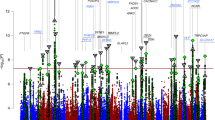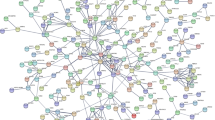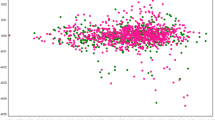Abstract
Bipolar disorder (BD) is associated with higher body mass index (BMI) and increased metabolic comorbidity. Considering the associated phenotypic traits in genetic studies of complex diseases, either by adjusting for covariates or by investigating interactions between genetic variants and covariates, may help to uncover the missing heritability. However, obesity-related traits have not been incorporated in prior genome-wide analyses of BD as covariates or potential interacting factors. To investigate the genetic factors underlying BD while considering BMI, we conducted genome-wide analyses using data from the Genetic Association Information Network BD study. We analyzed 729 454 genotyped single-nucleotide polymorphism (SNP) markers on 388 European-American BD cases and 1020 healthy controls with available data for maximum BMI. We performed genome-wide association analyses of the genetic effects while accounting for the effect of maximum BMI, and also evaluated SNP–BMI interactions. A joint test of main and interaction effects demonstrated significant evidence of association at the genome-wide level with rs12772424 in an intron of TCF7L2 (P=2.85E−8). This SNP exhibited interaction effects, indicating that the bipolar susceptibility risk of this SNP is dependent on BMI. TCF7L2 codes for the transcription factor TCF/LF, part of the Wnt canonical pathway, and is one of the strongest genetic risk variants for type 2 diabetes (T2D). This is consistent with BD pathophysiology, as the Wnt pathway has crucial implications in neurodevelopment, neurogenesis and neuroplasticity, and is involved in the mechanisms of action of BD and depression treatments. We hypothesize that genetic risk for BD is BMI dependent, possibly related to common genetic risk with T2D.
This is a preview of subscription content, access via your institution
Access options
Subscribe to this journal
Receive 12 print issues and online access
$259.00 per year
only $21.58 per issue
Buy this article
- Purchase on Springer Link
- Instant access to full article PDF
Prices may be subject to local taxes which are calculated during checkout


Similar content being viewed by others
References
Lichtenstein P, Yip BH, Bjork C, Pawitan Y, Cannon TD, Sullivan PF et al. Common genetic determinants of schizophrenia and bipolar disorder in Swedish families: a population-based study. Lancet 2009; 373: 234–239.
McGuffin P, Rijsdijk F, Andrew M, Sham P, Katz R, Cardno A . The heritability of bipolar affective disorder and the genetic relationship to unipolar depression. Arch Gen Psychiatry 2003; 60: 497–502.
Burton PR, Clayton DG, Cardon LR, Craddock N, Deloukas P, Duncanson A et al. Genome-wide association study of 14,000 cases of seven common diseases and 3,000 shared controls. Nature 2007; 447: 661–678.
Smith EN, Bloss CS, Badner JA, Barrett T, Belmonte PL, Berrettini W et al. Genome-wide association study of bipolar disorder in European American and African American individuals. Mol Psychiatry 2009; 14: 755–763.
Ferreira MA, O'Donovan MC, Meng YA, Jones IR, Ruderfer DM, Jones L et al. Collaborative genome-wide association analysis supports a role for ANK3 and CACNA1C in bipolar disorder. Nat Genet 2008; 40: 1056–1058.
Psychiatric GWAS Consortium Bipolar Disorder Working Group. Large-scale genome-wide association analysis of bipolar disorder identifies a new susceptibility locus near ODZ4. Nat Genet 2011; 43: 977–983.
Rzhetsky A, Wajngurt D, Park N, Zheng T . Probing genetic overlap among complex human phenotypes. Proc Natl Acad Sci USA 2007; 104: 11694–11699.
Sicras A, Rejas J, Navarro R, Serrat J, Blanca M . Metabolic syndrome in bipolar disorder: a cross-sectional assessment of a Health Management Organization database. Bipolar Disord 2008; 10: 607–616.
Cerimele JM, Katon WJ . Associations between health risk behaviors and symptoms of schizophrenia and bipolar disorder: a systematic review. Gen Hosp Psychiatry 2012; 35: 16–22.
McElroy SL, Keck PE Jr . Obesity in bipolar disorder: An overview. Curr Psychiatry Rep 2012; 14: 650–658.
McElroy SL, Kotwal R, Malhotra S, Nelson EB, Keck PE, Nemeroff CB . Are mood disorders and obesity related? A review for the mental health professional. J Clin Psychiatry 2004; 65: 634–651, quiz 730.
McElroy SL, Crow S, Biernacka JM, Winham S, Geske J, Barboza AB et al. Clinical phenotype of bipolar disorder with comorbid binge eating disorder. J Affect Disord 2013; 150: 981–986.
Yang J, Ferreira T, Morris AP, Medland SE, Madden PA, Heath AC et al. Conditional and joint multiple-SNP analysis of GWAS summary statistics identifies additional variants influencing complex traits. Nat Genet 2012; 44: 369–375.
Lopresti AL, Drummond PD . Obesity and psychiatric disorders: Commonalities in dysregulated biological pathways and their implications for treatment. Prog Neuropsychopharmacol Biol Psychiatry 2013; 45C: 92–99.
Kessler RC, Berglund PA, Chiu WT, Deitz AC, Hudson JI, Shahly V et al. The prevalence and correlates of binge eating disorder in the World Health Organization World Mental Health Surveys. Biol Psychiatry 2013; 73: 904–914.
Timpson NJ, Lindgren CM, Weedon MN, Randall J, Ouwehand WH, Strachan DP et al. Adiposity-related heterogeneity in patterns of type 2 diabetes susceptibility observed in genome-wide association data. Diabetes 2009; 58: 505–510.
Manning AK, Hivert M-F, Scott RA, Grimsby JL, Bouatia-Naji N, Chen H et al. A genome-wide approach accounting for body mass index identifies genetic variants influencing fasting glycemic traits and insulin resistance. Nat Genet 2012; 44: 659–681.
Wang X, Ding X, Su S, Spector TD, Mangino M, Iliadou A et al. Heritability of insulin sensitivity and lipid profile depend on BMI: evidence for gene-obesity interaction. Diabetologia 2009; 52: 2578–2584.
Mailman MD, Feolo M, Jin Y, Kimura M, Tryka K, Bagoutdinov R et al. The NCBI dbGaP database of genotypes and phenotypes. Nat Genet 2007; 39: 1181–1186.
Kraft P, Yen YC, Stram DO, Morrison J, Gauderman WJ . Exploiting gene-environment interaction to detect genetic associations. Hum Hered 2007; 63: 111–119.
Price AL, Patterson NJ, Plenge RM, Weinblatt ME, Shadick NA, Reich D . Principal components analysis corrects for stratification in genome-wide association studies. Nat Genet 2006; 38: 904–909.
Delaneau O, Zagury JF, Marchini J . Improved whole-chromosome phasing for disease and population genetic studies. Nat Methods 2013; 10: 5–6.
Howie B, Fuchsberger C, Stephens M, Marchini J, Abecasis GR . Fast and accurate genotype imputation in genome-wide association studies through pre-phasing. Nat Genet 2012; 44: 955–959.
Jin T, Liu L . The Wnt signaling pathway effector TCF7L2 and type 2 diabetes mellitus. Mol Endocrinol 2008; 22: 2383–2392.
Saxena R, Elbers CC, Guo Y, Peter I, Gaunt TR, Mega JL et al. Large-scale gene-centric meta-analysis across 39 studies identifies type 2 diabetes loci. Am J Hum Genet 2012; 90: 410–425.
Nobrega MA . TCF7L2 and Glucose Metabolism: Time to Look Beyond the Pancreas. Diabetes 2013; 62: 706–708.
Behrens J, vonKries JP, Kuhl M, Bruhn L, Wedlich D, Grosschedl R et al. Functional interaction of beta-catenin with the transcription factor LEF-1. Nature 1996; 382: 638–642.
Cadigan KM, Waterman ML . TCF/LEFs and Wnt signaling in the Nucleus. Cold Spring Harb Perspect Biol 2012; 4: a007906.
Saito-Diaz K, Chen TW, Wang XX, Thorne CA, Wallace HA, Page-McCaw A et al. The way Wnt works: Components and mechanism. Growth Factors 2013; 31: 1–31.
Budnik V, Salinas PC . Wnt signaling during synaptic development and plasticity. Curr Opin Neurobiol 2011; 21: 151–159.
Jang MH, Bonaguidi MA, Kitabatake Y, Sun J, Song J, Kang E et al. Secreted frizzled-related protein 3 regulates activity-dependent adult hippocampal neurogenesis. Cell Stem Cell 2013; 12: 215–223.
Seib DR, Corsini NS, Ellwanger K, Plaas C, Mateos A, Pitzer C et al. Loss of Dickkopf-1 restores neurogenesis in old age and counteracts cognitive decline. Cell Stem Cell 2013; 12: 204–214.
Wexler EM, Geschwind DH, Palmer TD . Lithium regulates adult hippocampal progenitor development through canonical Wnt pathway activation. Mol Psychiatry 2008; 13: 285–292.
Valvezan AJ, Klein PS . GSK-3 and Wnt Signaling in Neurogenesis and Bipolar Disorder. Front Mol Neurosci 2012; 5: 1.
Klein PS, Melton DA . A molecular mechanism for the effect of lithium on development. Proc Natl Acad Sci USA 1996; 93: 8455–8459.
O'Brien WT, Harper AD, Jove F, Woodgett JR, Maretto S, Piccolo S et al. Glycogen synthase kinase-3 beta haploinsufficiency mimics the behavioral and molecular effects of lithium. J Neurosci 2004; 24: 6791–6798.
Zhang F, Phiel CJ, Spece L, Gurvich N, Klein PS . Inhibitory phosphorylation of glycogen synthase kinase-3 (GSK-3) in response to lithium - Evidence for autoregulation of GSK-3. J Biol Chem 2003; 278: 33067–33077.
O'Brien WT, Huang J, Buccafusca R, Garskof J, Valvezan AJ, Berry GT et al. Glycogen synthase kinase-3 is essential for beta-arrestin-2 complex formation and lithium-sensitive behaviors in mice. J Clin Invest 2011; 121: 3756–3762.
Beaulieu JM, Marion S, Rodriguiz RM, Medvedev IO, Sotnikova TD, Ghisi V et al. A beta-arrestin 2 signaling complex mediates lithium action on behavior. Cell 2008; 132: 125–136.
Gould TD, Einat H, O'Donnell KC, Picchini AM, Schloesser RJ, Manji HK . Beta-catenin overexpression in the mouse brain phenocopies lithium-sensitive Behaviors. Neuropsychopharmacology 2007; 32: 2173–2183.
Zhou R, Yuan P, Wang Y, Hunsberger JG, Elkahloun A, Wei Y et al. Evidence for selective microRNAs and their effectors as common long-term targets for the actions of mood stabilizers. Neuropsychopharmacology 2009; 34: 1395–1405.
Brennand KJ, Simone A, Jou J, Gelboin-Burkhart C, Tran N, Sangar S et al. Modelling schizophrenia using human induced pluripotent stem cells. Nature 2011; 473: 221–225.
Voleti B, Duman RS . The roles of neurotrophic factor and Wnt signaling in depression. Clin Pharmacol Ther 2012; 91: 333–338.
Gottardi CJ, Wong E, Gumbiner BM . E-cadherin suppresses cellular transformation by inhibiting beta-catenin signaling in an adhesion-independent manner. J Cell Biol 2001; 153: 1049–1059.
Heuberger J, Birchmeier W . Interplay of cadherin-mediated cell adhesion and canonical Wnt signaling. Cold Spring Harb Perspect Biol 2010; 2: a002915.
Blair IP, Chetcuti AF, Badenhop RF, Scimone A, Moses MJ, Adams LJ et al. Positional cloning, association analysis and expression studies provide convergent evidence that the cadherin gene FAT contains a bipolar disorder susceptibility allele. Mol Psychiatry 2006; 11: 372–383.
Soronen P, Ollila HM, Antila M, Silander K, Palo OM, Kieseppa T et al. Replication of GWAS of bipolar disorder: association of SNPs near CDH7 with bipolar disorder and visual processing. Mol Psychiatry 2010; 15: 4–6.
Lydall GJ, Bass NJ, McQuillin A, Lawrence J, Anjorin A, Kandaswamy R et al. Confirmation of prior evidence of genetic susceptibility to alcoholism in a genome-wide association study of comorbid alcoholism and bipolar disorder. Psychiatr Genet 2011; 21: 294–306.
Redies C, Hertel N, Hubner CA . Cadherins and neuropsychiatric disorders. Brain Res 2012; 1470: 130–144.
Cichon S, Muhleisen TW, Degenhardt FA, Mattheisen M, Miro X, Strohmaier J et al. Genome-wide association study identifies genetic variation in neurocan as a susceptibility factor for bipolar disorder. Am J Hum Genet 2011; 88: 372–381.
Del Mare S, Salah Z, Aqeilan RI . WWOX: Its Genomics, Partners, and Functions. J Cell Biochem 2009; 108: 737–745.
Bouteille N, Driouch K, Hage PE, Sin S, Formstecher E, Camonis J et al. Inhibition of the Wnt/beta-catenin pathway by the WWOX tumor suppressor protein. Oncogene 2009; 28: 2569–2580.
Acknowledgements
This study was supported by funding from the Marriott Family Foundation and Mayo Clinic’s Center for Individualized Medicine. Funding support for the Whole Genome Association Study of Bipolar Disorder was provided by the National Institute of Mental Health (NIMH) and the genotyping of samples was provided through the Genetic Association Information Network (GAIN). The data sets used for the analyses described in this manuscript were obtained from the database of Genotypes and Phenotypes (dbGaP) found at http://www.ncbi.nlm.nih.gov/gap through dbGaP accession number phs000017.v3.p1. Samples and associated phenotype data for the Collaborative Genomic Study of Bipolar Disorder were provided by the NIMH Genetics Initiative for Bipolar Disorder.
Author information
Authors and Affiliations
Corresponding author
Ethics declarations
Competing interests
Dr McElroy is a consultant to or member of the scientific advisory boards of Alkermes, Bracket, Corcept, MedAvante, Shire, and Teva. She is a principal or co-investigator on studies sponsored by Alkermes, AstraZeneca, Cephalon, Eli Lilly and Company, Forest, Marriott Foundation, Orexigen Therapeutics, Inc., Pfizer, Shire, Takeda Pharmaceutical Company Ltd, and Transcept Pharmaceutical, Inc. She is also an inventor on United States Patent No. 6,323,236 B2, Use of Sulfamate Derivatives for Treating Impulse Control Disorders, and along with the patient’s assignee, University of Cincinnati, Cincinnati, Ohio, has received payments from Johnson & Johnson, which has exclusive rights under the patent. Dr Crow has received research grants from Shire, Alkermes and Phillips Respironics. Dr Frye has had grant support from Pfizer and Myriad, and has served as an unpaid consultant for Allergan, Myriad, Sunovion and Teva Pharmaceuticals. The remaining authors declare no conflict of interest.
Additional information
Supplementary Information accompanies the paper on the Molecular Psychiatry website
Supplementary information
PowerPoint slides
Rights and permissions
About this article
Cite this article
Winham, S., Cuellar-Barboza, A., Oliveros, A. et al. Genome-wide association study of bipolar disorder accounting for effect of body mass index identifies a new risk allele in TCF7L2. Mol Psychiatry 19, 1010–1016 (2014). https://doi.org/10.1038/mp.2013.159
Received:
Revised:
Accepted:
Published:
Issue Date:
DOI: https://doi.org/10.1038/mp.2013.159
Keywords
This article is cited by
-
TCF7L2 lncRNA: a link between bipolar disorder and body mass index through glucocorticoid signaling
Molecular Psychiatry (2021)
-
Genome-wide DNA methylation analysis of heavy cannabis exposure in a New Zealand longitudinal cohort
Translational Psychiatry (2020)
-
Canonical Wnt Signaling Modulates the Expression of Pre- and Postsynaptic Components in Different Temporal Patterns
Molecular Neurobiology (2020)
-
Statistical methods for testing X chromosome variant associations: application to sex-specific characteristics of bipolar disorder
Biology of Sex Differences (2019)
-
Investigation of multi-trait associations using pathway-based analysis of GWAS summary statistics
BMC Genomics (2019)



